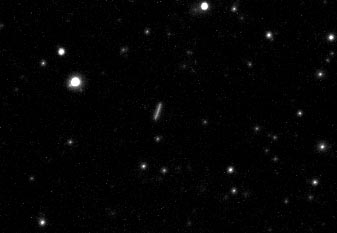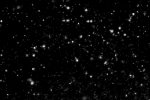ASTEROID 2002 NY40's
FLYBY OF AUGUST 18, 2002

Marco Verstraaten of Astropage took this CCD-image
of asteroid 2002 NY40 on August 17, 22:45 UT, with an
Audine CCD camera and f5.6/300 mm lens. Exposure
time: 40 seconds.

More images:

Finder charts and efemerides:
SKY & TELESCOPE's AstroAlert for Minor Planets
August 15, 2002
FLYBY OF 2002 NY40
On Saturday night, August 17-18, observers in Europe, Africa,
and the Americas are very well positioned to observe the flyby
of 2002 NY40, a recently discovered near-Earth asteroid. During
that night alone it passes through five constellations,
beginning in Sagitta and ending up in Hercules.
As mentioned in an earlier AstroAlert, this 0.5-km object passes only a little outside the Moon's orbit. It is expected to become as bright as 9th magnitude in the hours leading up to closest approach, which occurs near 7:47 Universal Time on August 18th. Observers with small telescopes and even binoculars should be able to witness this rare event.
Using a magnification of 50x or more, skywatchers should have no trouble perceiving the object's motion as it glides by background stars in the field of view. It will be moving at up to 8 arcminutes per minute of time!
Sky & Telescope has prepared four detailed finder charts for 2002 NY40, showing its path across a 60-degree arc of sky that night. These charts are PDFs, meaning they can be viewed or printed on a computer that has Acrobat Reader (free downloadable software).
For links to the charts, see our updated article on the flyby. The links to the charts are on page 2.
Instead of a single track, the charts show individual tracks as seen from five different cities: London, Johannesburg, Boston, Buenos Aires, and Los Angeles. The idea is that you can estimate the asteroid's track for your own location using these cities for reference. The magnitude limit for stars is 8.6.
These charts were prepared with the help of the Minor Planet Center's Ephemeris Service, a valuable resource in any close encounter of this type.
After printing out one of our charts, you must orient it to match the field of view of your telescope. To simplify this process, Lawrence Garrett (Association of Lunar and Planetary Observers) has devised a clever observing aid that can be built from simple hardware items.
Good luck observing this rather unusual event!
Roger W. Sinnott
Senior Editor
Sky & Telescope
NASA Science News for July 30, 2002
Look at that Asteroid
There's no danger of a collision. Even so, a big space rock will soon
come so close to Earth that sky watchers can see it through binoculars.
================================================================== This Is SKY & TELESCOPE's AstroAlert for Minor Planets ==================================================================
NEXT MONTH'S FLYBY OF 2002 NY40
In mid-August, a newly discovered asteroid will pass close enough
to Earth that it should be easy to spot in small telescopes and
even binoculars. This object was first detected on July 14th by
astronomers using the LINEAR 1-meter survey telescope in New
Mexico, and it has now been designated 2002 NY40 by the Minor
Planet Center in Cambridge, Massachusetts. According to
calculations by the center's associate director, Gareth V.
Williams, it is traveling in a low-inclination, Apollo-type
orbit with a period of 3.03 years. Its August 18th flyby should
bring it to within 530,000 kilometers (330,000 miles) of Earth,
which is just outside the Moon's distance.
There are several key differences between this encounter and that of 2002 MN, which made news a few weeks ago. That object came well inside our own Moon's orbit and was not detected until several days after the fact. The new asteroid was found on its way in toward the Sun, a full month before its own flyby. But 2002 NY40 is about 10 times larger than 2002 MN; the best current estimates make it about half a kilometer (a third of a mile) across.
Still quite faint at magnitude 18 in the constellation Aquarius, 2002 NY40 is making a very tight loop around the star Beta Aquarii. During the next few weeks it will brighten tremendously and yet remain almost motionless in the sky -- the eerie signature of an asteroid hurtling right toward the Earth! Then it veers off to the northwest as it goes by, racing past the double star Albireo in Cygnus for observers in the Western Hemisphere on the night of August 17-18.
On that Saturday evening, 2002 NY40 should become as bright as magnitude 9.3 during the period when it is well placed for viewing from North America. Its angular velocity will exceed 4 arcminutes per minute, a motion easily perceptible in small telescopes. Sky & Telescope plans to issue detailed observing instructions, through AstroAlerts and SkyandTelescope.com, in the days leading up to this rare event.
A mere 24 hours after it goes by, 2002 NY40 plunges hopelessly beyond reach of Earth-based telescopes as it heads in toward the Sun. (We are then viewing its unilluminated backside, which explains why it becomes so faint, so fast.)
Meanwhile, professional astronomers are gearing up to make the most of this encounter. "2002 NY40 is a potentially very good radar target for mid-August," notes Mike Nolan of Arecibo Observatory and Cornell University. In a message posted on the Minor Planet Mailing List, Nolan urges advanced amateurs to obtain detailed photometry of the asteroid on the nights leading up to the flyby. A good light curve, revealing the object's rotation rate, would help in selecting the instrumentation to be used with the Arecibo 1,000-foot radio dish.
While there is no danger of 2002 NY40 striking the Earth during this flyby, a future impact has not been ruled out. Both NEODyS, operated by the University of Pisa, and NASA's Near-Earth Object Program Office at JPL have identified a number of very close encounters in the years to come. These occur either around August 18th as the asteroid heads in toward the Sun, or else near February 14th when it is on the way out. Both agencies are focusing a flyby just 20 years from now (on August 18, 2022), when there appears to be a 1-in-500,000 chance of an impact -- extremely unlikely, but worrisome just the same.
Roger W. Sinnott
Senior Editor
Sky & Telescope
----------------------------------------------------------------
The following ephemeris, adapted from the Minor Planet Ephemeris Service, gives the object's right ascension and declination at 0h Universal Time on successive dates. Also listed are its distance from the Earth (Delta) and Sun (r) in astronomical units, 1 a.u. being 149,600,000 kilometers. The last column is the predicted visual magnitude.
Because this is a newly discovered object passing fairly close to the Earth, the ephemeris is still somewhat uncertain (especially on the final dates listed). Keep in mind that these positions are geocentric; parallax at closest approach could shift the object's position by 1/2 degree or more depending on observer's geographic location. (To display the ephemeris properly, your e-mail program should be set to use a fixed-space font such as Courier.)
Ephemeris of 2002 NY40
Date R.A. (2000) Decl. Delta r V
(0h UT) h m o ' a.u. a.u. mag.
Jul 22 21 33.8 -05 46 0.347 1.336 18.2
Jul 23 21 34.0 -05 41 0.333 1.325 18.1
Jul 24 21 34.1 -05 37 0.319 1.313 18.0
Jul 25 21 34.3 -05 32 0.306 1.302 17.8
Jul 26 21 34.4 -05 27 0.292 1.290 17.7
Jul 27 21 34.6 -05 23 0.279 1.278 17.6
Jul 28 21 34.6 -05 18 0.266 1.267 17.4
Jul 29 21 34.7 -05 13 0.253 1.255 17.3
Jul 30 21 34.8 -05 09 0.240 1.243 17.1
Jul 31 21 34.8 -05 04 0.227 1.232 17.0
Aug 01 21 34.7 -04 59 0.214 1.220 16.8
Aug 02 21 34.7 -04 54 0.201 1.208 16.6
Aug 03 21 34.6 -04 49 0.188 1.196 16.5
Aug 04 21 34.5 -04 43 0.176 1.185 16.3
Aug 05 21 34.3 -04 37 0.163 1.173 16.1
Aug 06 21 34.0 -04 31 0.151 1.161 15.9
Aug 07 21 33.7 -04 24 0.138 1.149 15.6
Aug 08 21 33.4 -04 16 0.126 1.137 15.4
Aug 09 21 32.9 -04 08 0.113 1.125 15.1
Aug 10 21 32.3 -03 57 0.101 1.113 14.8
Aug 11 21 31.5 -03 44 0.089 1.101 14.5
Aug 12 21 30.5 -03 28 0.077 1.089 14.2
Aug 13 21 29.1 -03 06 0.065 1.077 13.8
Aug 14 21 27.0 -02 35 0.053 1.064 13.3
Aug 15 21 23.7 -01 46 0.040 1.052 12.8
Aug 16 21 17.7 -00 16 0.028 1.040 12.1
Aug 17 21 03.1 +03 23 0.017 1.028 11.0
Aug 18 19 39.2 +22 26 0.005 1.016 9.4
Aug 19 10 50.2 +21 39 0.009 1.004 21.0
Aug 20 10 06.4 +12 09 0.020 0.992 49.7
--------------------------------------------------------
==================================================================
AstroAlert is a free service of SKY & TELESCOPE, the Essential
Magazine of Astronomy (http://SkyandTelescope.com/). This e-mail
was sent to AstroAlert subscribers.
==================================================================
 Back to ASTRONET's home page
Back to ASTRONET's home page